REPAIRS PAGE 73
BRAKE PEDAL CHECK AND ADJUSTMENT
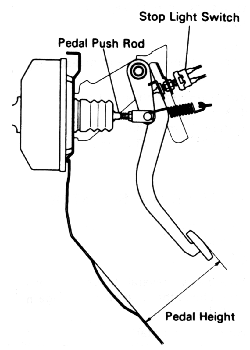 |
- 1. Check that pedal height is correct, as shown
- Pedal height from asphalt sheet: 154 - 164mm (6.06 - 6.46 in.)
- 2. If necessary, adjust pedal height
- (a) If necessary, remove the instrument lower finish panel and air
duct.
- (b) Loosen the stop light switch lock nut.
- (c) Sufficiently loosen the stop light switch.
- (d) Loosen the push rod lock nut.
- (e) Adjust the pedal height by turning the pedal push rod.
- (f) Return the stop light switch until it lightly contacts the pedal
stopper.
- (g) Tighten the two lock nuts.
- (h) Check that the stop lights light when the brake pedal is
depressed.
- (i) After adjusting the pedal heights, check and adjust the pedal
freeplay.
|
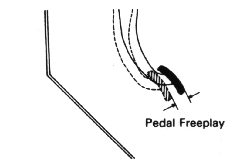 |
- 3. Check that pedal free play is correct, as shown
- (Single type brake booster)
- (a) Stop the engine and depress the brake pedal several times until
there is no more vacuum left in the booster.
- (b) Push in the pedal until the beginning of resistance is felt.
Measure the distance, as shown.
- Pedal free play: 3 - 6 mm (0.12 - 0.24 in.)
- NOTE: The pedal free play is the amount of the stroke until the
booster air valve is moved by the pedal push rod.
- If necessary, adjust pedal free play
- (a) If incorrect, adjust the pedal free play by turning the pedal
push rod.
- (b) Start the engine and confirm that pedal free play exists.
- (c) After adjusting the pedal free play, check the pedal height.
- (d) Install the air duct and instrument lower finish panel.
|
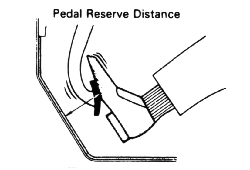 |
- 5. Check that pedal reserve distance is correct, as
shown
- Release the parking brake.
- With engine running, depress the pedal and measure the pedal reserve
distance, as shown.
- Pedal reserve distance from asphalt sheet at
- 50 kg (110.2 lb, 490 N):
- 4A-GE = more than 87 mm (3.43 in.)
- 4A-GZE = More than 77 mm (3.03 in.)
- If incorrect, troubleshoot the brake system.
|
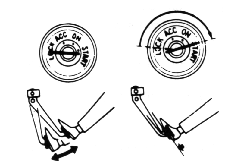 |
Operational Test of Brake Booster
- NOTE: If available, use a brake booster tester to check the booster
operating condition.
- 1. Operating Check
- (a) Depress the brake pedal several times with the engine stopped,
and check that there is no change in the pedal reserve distance.
- (b) Depress the brake pedal and start the engine. If the pedal goes
down slightly, operation is normal.
|
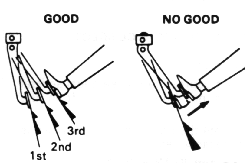 |
- 2. Air Tightness Check
- (a) Start the engine and stop it after one or two minutes. Depress
the brake pedal several times slowly. If the pedal goes down furthest
the first time, but gradually rises after the second or third time, the
booster is air tight.
- (b) Depress the brake pedal while the engine is running, and stop it
with the pedal depressed. If there is no change in pedal reserve travel
after holding the pedal for thirty seconds, the booster is air tight.
|
Back to repairs index page
Back to main page









